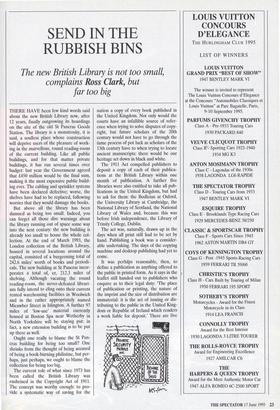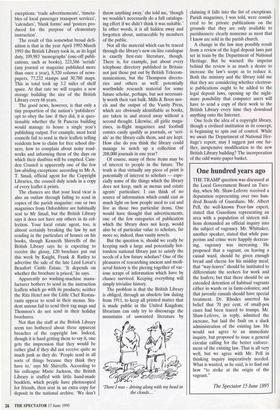SEND IN THE RUBBISH BINS
The new British Library is not too small,
complains Ross Clark, but
far too big
THERE HAVE been few kind words said about the new British Library now, after 12 years, finally outgrowing its hoardings on the site of the old St Pancras Goods Station. The library is a monstrosity, it is said, a soulless place whose construction will deprive users of the pleasure of work- ing in the marvellous, round reading-room of the current building. Like all public buildings, and for that matter private buildings, it has run several times over budget: last year the Government agreed that £450 million would be the final sum, making it the most expensive public build- ing ever. The cabling and sprinkler systems have been declared defective; worse, the shelves have had to be replaced, following worries that they would damage the books.
But above all the library has been damned as being too small. Indeed, you can forget all those dire warnings about the library running out of space some way into the next century: the new building is already too small to house the whole col- lection. At the end of March 1993, the London collection of the British Library, housed in several locations around the capital, consisted of a burgeoning total of 242.6 miles' worth of books and periodi- cals. The new building at St Pancras incor- porates a total of, er, 212.3 miles of shelving. Although vacating the round reading-room, the never-defeated librari- ans fully intend to cling onto their current rented warehousing facilities in Woolwich and in the rather appropriately named Micawber Street in Islington. A further 97 miles of low-use' material currently housed at Boston Spa near Wetherby in North Yorkshire will be staying put: in fact, a new extension building is to be put up there as well.
Ought one really to blame the St Pan- cras building for being too small? One shrinks from the thought of being accused of being a book-burning philistine, but per- haps, just perhaps, we ought to blame the collection for being too big.
The current role of what since 1973 has been called the British Library was enshrined in the Copyright Act of 1911. The concept was worthy enough: to pro- vide a systematic way of saving for the nation a copy of every book published in the United Kingdom. Not only would the courts have an infallible source of refer- ence when trying to solve disputes of copy- right, but future scholars of the 20th century would not have to go through the same process of pot luck as scholars of the 13th century have to when trying to locate ancient manuscripts: there would be our heritage set down in black and white.
The 1911 Act compelled publishers to deposit a copy of each of their publica- tions at the British Library within one month of publication. A further five libraries were also entitled to take all pub- lications in the United Kingdom, but had to ask for them: the Bodleian at Oxford, the University Library at Cambridge, the National Library of Scotland, the National Library of Wales and, because this was before Irish independence, the Library of Trinity College, Dublin.
The act was, naturally, drawn up in the days when all print still had to be set by hand. Publishing a book was a consider- able undertaking. The days of the copying machine and desktop publishing had yet to come.
It was perhaps reasonable, then, to define a publication as anything offered to the public in printed form. As it says in the leaflet still handed out to publishers who enquire as to their legal duty: 'The place of publication or printing, the nature of the imprint and the size of distribution are immaterial: it is the act of issuing or dis- tributing to the public in the United King- dom or Republic of Ireland which renders a work liable for deposit.' There are five exceptions: 'trade advertisements', 'timeta- bles of local passenger transport services', `calendars', 'blank forms' and 'posters pro- duced for the purpose of elementary instruction'.
The result of this somewhat broad defi- nition is that in the year April 1992-March 1993 the British Library took in, as its legal duty, 109,983 'monographs' (one-off publi- cations, such as books), 223,586 'serials' (any journal or magazine published more than once a year), 8,320 volumes of news- papers, 77,232 stamps and 30,780 maps. This in total took up 3.2 miles of shelf space. At that rate we will require a new storage building the size of the British Library every 66 years.
The good news, however, is that only a tiny proportion of the nation's 'publishers' opt to obey the law: if they did, it is ques- tionable whether the St Pancras building would manage to house a single year's publishing output. For example, most local councils fail to send in their leaflets telling residents how to claim for free school din- ners, how to complain about noisy road- works and informing them of the days on which their dustbins will be emptied. Cam- den Council is apparently one of the few law-abiding exceptions: according to Mr A. T. Smail, official agent for the Copyright Libraries, the council duly sends in a copy of every leaflet it prints.
The chances are that your local vicar is also an outlaw through failing to send in copies of the parish magazine: one or two magazines from Oxfordshire are habitually sent to Mr Smail, but the British Library says it does not have any others in its col- lection. Your local estate agent, too, is almost certainly breaking the law by not sending in the particulars of houses on his books, though Kenneth Shirreffs of the British Library says he is expecting to receive the glossy, £20 brochure put out this week by Knight, Frank & Rutley to advertise the sale of the late Lord Lovat's Beaufort Castle Estate. 'It depends on whether the brochure is priced,' he says.
Apparently no washing-machine manu- facturer bothers to send in the instruction leaflets which go with its products; neither the Ritz Hotel nor the Little Chef Restau- rants appear to send in their menus. Stu- dent unions fail to send their rag mags and Thomson's do not send in their holiday brochures.
Not that the staff at the British Library seem too bothered about these apparent breaches of the copyright law. Indeed, though it is hard getting them to say it, one gets the impression that they would be rather glad if they did not receive quite as much junk as they do. 'People send in all sorts of things because they think they have to,' says Mr Shirreffs. According to his colleague Marie Jackson, the British Library is stuffed with little hand-made booklets, which people have photocopied for friends, then sent in an extra copy for deposit in the national archive. 'We don't throw anything away,' she told me, 'though we wouldn't necessarily do a full catalogu- ing effort if we didn't think it was suitable.' In other words, it is all hidden away and forgotten about, untraceable by members of the public.
Not all the material which can be traced through the library's new on-line catalogue is exactly first-rate literature, though. There is, for example, just about every telephone directory published in Britain: not just those put out by British Telecom- munications, but the Thompson directo- ries and others as well: potentially worthwhile research material for some future scholar, perhaps, but not necessari- ly worth their vast bulk. Mills & Boon nov- els and the output of the Vanity Press, which are obviously identifiable as books, are taken in and stored away without a second thought. Likewise, all girlie maga- zines, in-flight magazines and football comics easily qualify as journals, or 'seri- als' as the library calls them, and are kept. How else do you think the library could manage to notch up a collection of 208,000 journals in one year?
Of course, many of these items may be of interest to people in the future. The truth is that virtually any piece of print is potentially of interest to scholars — espe- cially some of the things which the library does not keep, such as menus and estate agents' particulars: I can think of no source of information which could cast as much light on how people used to eat and live as those two particular items. One would have thought that advertisements, one of the few categories of publication which the library does not keep, would also be of particular value to scholars, far more so, indeed, than vanity novels.
But the question is, should we really be keeping such a large and potentially bot- tomless national library just to satisfy the needs of a few future scholars? One of the pleasures of researching ancient and medi- aeval history is the piecing together of var- ious scraps of information which have by chance survived. Keeping everything will simply trivialise history.
The problem is that the British Library is obliged, through an obsolete law dating from 1911, to keep all printed matter that is made public in the United Kingdom; librarians can only try to discourage the mountains of unwanted literature by `There I was - driving along with my head in the clouds... ' claiming it falls into the list of exceptions. Parish magazines, I was told, were consid- ered to be private publications on the grounds that they are only available to parishioners: clearly nonsense as most that I know are sold in the parish church.
A change in the law may possibly result from a review of the legal deposit laws just set in train by the Department of National Heritage. But be warned: the impetus behind the review is as much a desire to increase the law's scope as to reduce it. Both the ministry and the library told me that they are considering whether electron- ic publications ought to be added to the legal deposit laws, opening up the night- mare possibility that, computer users will have to send a copy of their work to the British Library every time they download anything onto the Internet.
One feels the idea of a copyright library, though a civilised institution in its concept, is beginning to spin out of control. While we await the Department of National Her- itage's report, may I suggest just one fur- ther, inexpensive modification to the new British Library building? The incorporation of the odd waste-paper basket.



































































 Previous page
Previous page